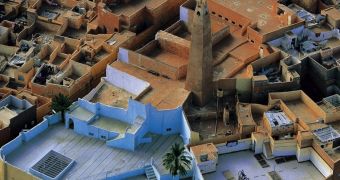At the beginning of the 17th century, a Berber tribe took refuge in a totally arid area in the heart of Sahara, 400 mi (640 km) south of Alger. The oued (temporary desert river) called Mzab, which irrigates the plateau and the dry valleys once a year, gave its name to the region and the people established here were called Mozabites.
The Berbers who came on this barren plateau built five cities of great beauty. Later, the growth of the population imposed the building of another two cities.
The water, so necessary in this dry region, is drained to basins carved by hand to depths up to 200 ft (66 m). The waters of the oued, which have a sudden flow once a year, are kept by dams and subsequently distributed, in an economical way, through the ditches, to the date palm plantations surrounding each city. The Mzab region, with an arid and hot clime, was turned by Berbers into a cozy oasis, one of the most beautiful in Sahara, and extremely admired by tourists.
The oasis produces about 74 strains of dates, the most famous being "Deglet Nour". At the shadow of the date trees, the inhabitants cultivate vegetables, greens and flowers.
The most important city is Ghardala, built on the ridge of a hill and dominated by a mosque. The name comes from "Ghar-Daya" (the Grotto of Daya). The legend says that a sheik passing through the area saw a beautiful woman he fell in love with, married her and founded the city, together with other people in the area.
The fortress has not changed in time, keeping its old architecture. Inside their city-fortresses, the Mozabites remained out of the external influences.
The houses are cubic and painted in beige, white and ochre; through their simple line and originality, they impressed and inspired many French architects, like Corbusier, for the chapel of Ronchamp. Along the sinuous labyrinth of the streets, no car parking exists, and here everybody walks on foot or rides a donkey.
The houses have few and narrow windows, keeping cool and the women out of the sight of strangers. In fact, the religiosity of these people is one of the factors that preserved their lifestyle until today.
Women are allowed to go out just to the mosque and cemetery. They gather for praying at the beautiful tombs from Sidi Aisa and Melika. They wear the Muslim veil from the age of the engagement, which can take place when they are just 8-9 years old.

 14 DAY TRIAL //
14 DAY TRIAL //